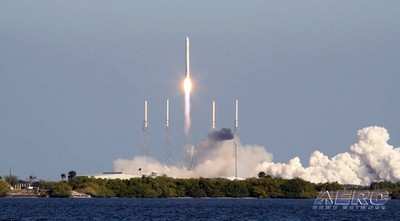Thu, Mar 21, 2013
Musk: Engine 'Successfully Performed Every Test'
Space Exploration Technologies’ (SpaceX) Merlin 1D engine has achieved flight qualification, a major milestone for the next generation Merlin engine. Through a 28 test qualification program, the Merlin 1D accumulated 1,970 seconds of total test time, the equivalent run time of over 10 full mission durations, and is now fully qualified to fly on the Falcon 9 rocket.

The program included four tests at or above the power (147,000 pounds of thrust) and duration (185 seconds) required for a Falcon 9 rocket launch. The Merlin 1D engine was also tested at propellant inlet and operating conditions that were well outside the bounds of expected flight conditions.
SpaceX's testing program demonstrated a ratio of 4:1 for critical engine life parameters such as firing duration and restart capacity to the engine's expected flight requirements. The industry standard is 2:1.
“The Merlin 1D successfully performed every test throughout this extremely rigorous qualification program,” said Elon Musk, SpaceX CEO and chief designer. “With flight qualification now complete, we look forward to flying the first Merlin 1D engines on Falcon 9’s Flight 6 this year.”
The Merlin 1D builds on the technology of the Merlin engines used on the first five flights of Falcon 9. With nine Merlin 1Ds on the first stage, the Falcon 9 rocket will produce nearly 1.5 million pounds of thrust in a vacuum. The Merlin 1D has a vacuum thrust-to-weight ratio exceeding 150, the best of any liquid rocket engine in history. This enhanced design makes the Merlin 1D the most efficient booster engine ever built, while still maintaining the structural and thermal safety margins needed to carry astronauts. Additionally, the new engine is designed for improved manufacturability by using higher efficiency processes, increased robotic construction and reduced parts count.
Testing took place at SpaceX's rocket development facility in McGregor, Texas.
(Falcon 9 launch image from file)
More News
Pilot Also Reported That Due To A Fuel Leak, The Auxiliary Fuel Tanks Were Not Used On June 4, 2025, at 13:41 eastern daylight time, a Piper PA-23, N2109P, was substantially damage>[...]
Have A Story That NEEDS To Be Featured On Aero-News? Here’s How To Submit A Story To Our Team Some of the greatest new stories ANN has ever covered have been submitted by our>[...]
From 2023 (YouTube Edition): Reflections on War’s Collective Lessons and Cyclical Nature The exigencies of war ought be colorblind. Inane social-constructs the likes of racis>[...]
Aero Linx: Colorado Pilots Association (CPA) Colorado Pilots Association was incorporated as a Colorado Nonprofit Corporation in 1972. It is a statewide organization with over 700 >[...]
High Speed Taxiway A long radius taxiway designed and provided with lighting or marking to define the path of aircraft, traveling at high speed (up to 60 knots), from the runway ce>[...]
 NTSB Prelim: Piper PA-23
NTSB Prelim: Piper PA-23 ANN FAQ: Submit a News Story!
ANN FAQ: Submit a News Story! Classic Aero-TV: One Mans Vietnam
Classic Aero-TV: One Mans Vietnam ANN's Daily Aero-Linx (07.03.25)
ANN's Daily Aero-Linx (07.03.25) ANN's Daily Aero-Term (07.03.25): High Speed Taxiway
ANN's Daily Aero-Term (07.03.25): High Speed Taxiway



